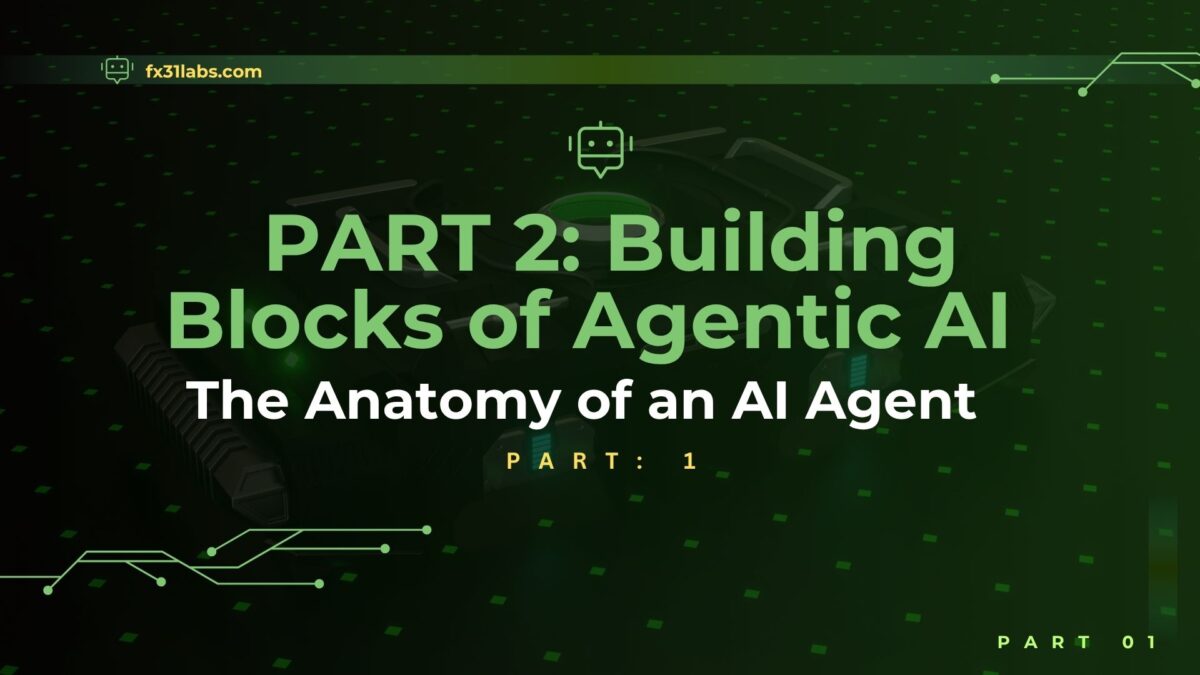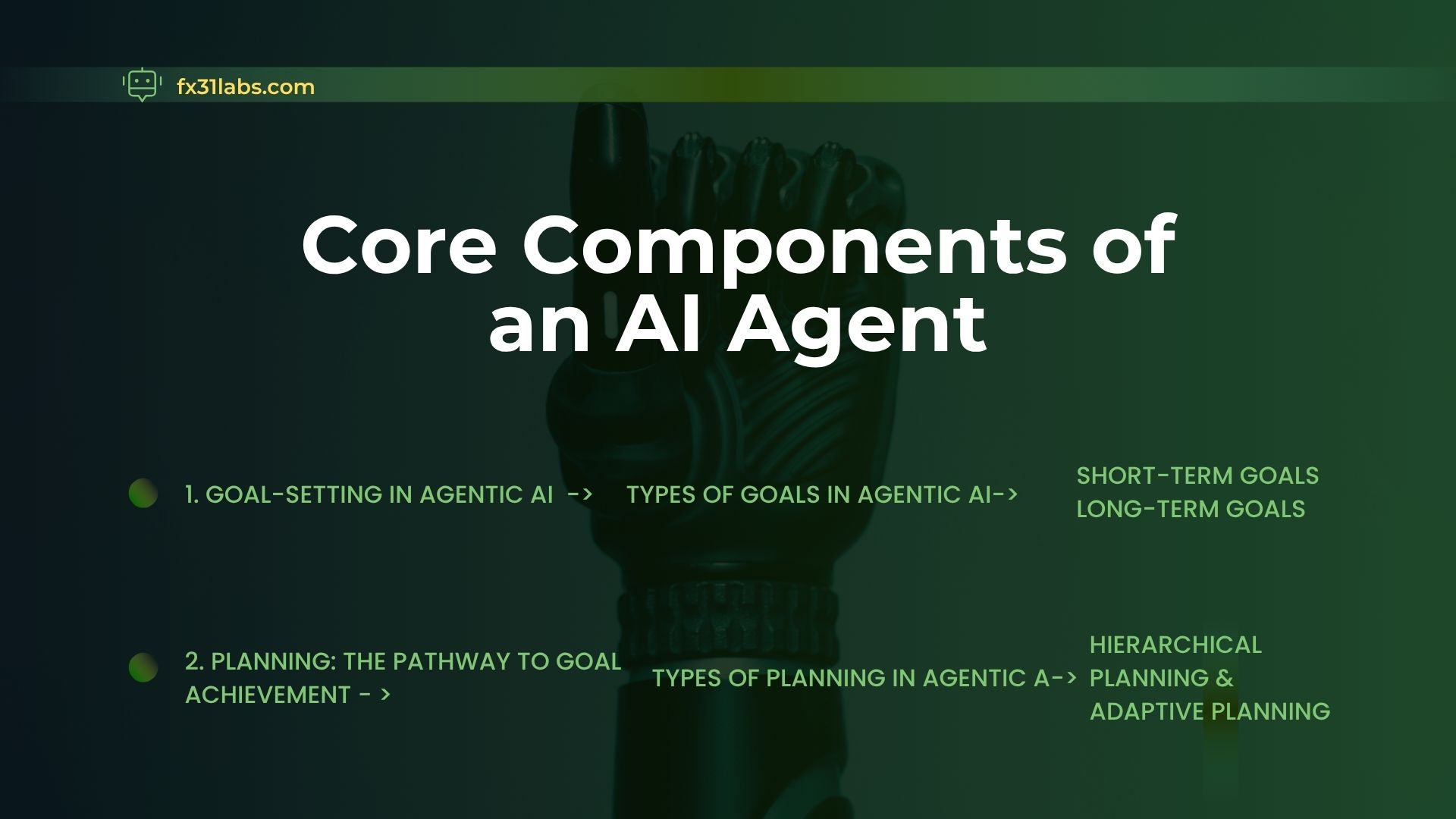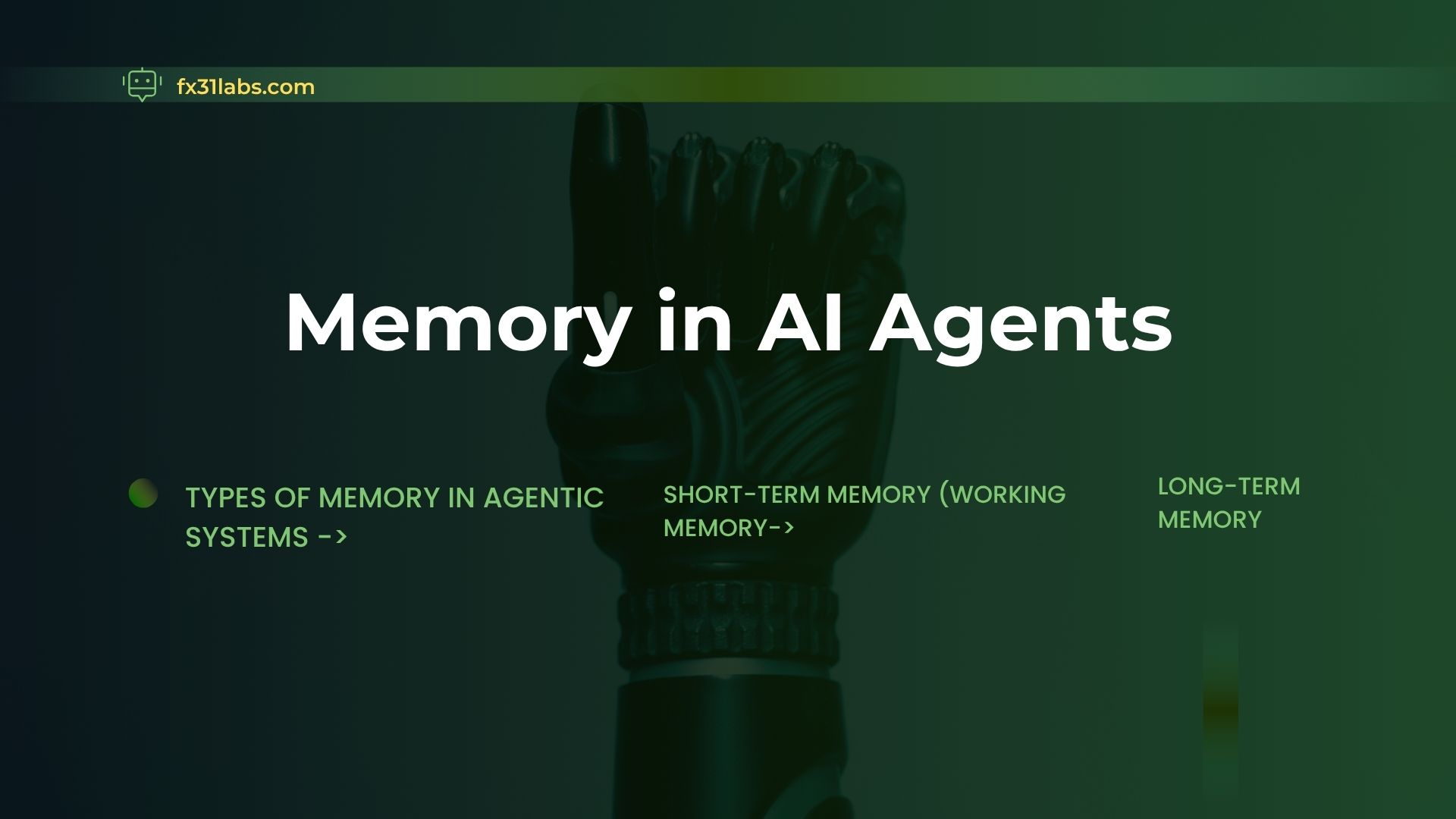The Anatomy of an AI Agent: Goal-Setting, Memory & Execution Explained

I. Introduction: The Building Blocks of Agentic AI
Brief Recap of Part 1: Transition from Traditional Automation to Agentic AI
In the previous blog, we explored how the rise of Agentic AI is reshaping the landscape of business automation. While traditional automation relies on fixed processes to perform repetitive tasks, Agentic AI takes things a step further by incorporating dynamic, adaptive capabilities that enable machines to think, plan, and act autonomously.
This shift is crucial for businesses that want to stay competitive in an era where speed, agility, and scalability are essential for success. The transformation from static automation to Agentic AI is not just a technical upgrade but a strategic advantage that helps enterprises unlock new possibilities in efficiency and innovation.
Importance of Understanding the Anatomy of AI Agents
To truly harness the power of Agentic AI, it’s essential to understand how these systems operate and what makes them work. Think of an AI agent as a “digital brain” designed to carry out specific tasks, make decisions, and adapt to changing circumstances. By dissecting the core components that form an AI agent, businesses can better implement these systems in a way that aligns with their long-term goals.
The goal of this post is to provide a detailed exploration of the core components that make up an AI agent, including:
- Goal-setting
- Planning
- Memory
- Perception
- Execution
These building blocks work together to allow AI agents to carry out tasks autonomously, make decisions, learn from their environment, and continuously improve.
Goal of This Post
In this post, we will focus on the first two critical components of an AI agent: Goal-setting and Planning. Understanding these components will provide a foundational insight into how Agentic AI can drive real-world business processes, streamline operations, and create smarter solutions.
II. Core Components of an AI Agent

1. Goal-Setting in Agentic AI
Goal-setting is the starting point for any AI agent. Just like humans, AI agents need a clear direction or purpose to operate effectively. Without goals, an AI agent would have no framework for decision-making or action.
Definition: How Goal-Setting Forms the Foundation
Goal-setting in Agentic AI enables the system to identify desired outcomes and the necessary steps to achieve them. An agent with clear goals can adapt its actions based on environmental changes and feedback, ensuring that it continuously works toward achieving those goals.
Also read: Why Agentic AI Matters in 2025 (And Beyond)
Types of Goals in Agentic AI:
- Short-Term Goals: These are simple, task-oriented objectives that the AI needs to complete quickly. Examples include fetching data from an API, sending an email, or responding to a customer query. These tasks typically require minimal decision-making and can be executed in a short timeframe.Example: An AI agent designed to assist in customer service might have a short-term goal of resolving a customer’s inquiry within 5 minutes. It collects relevant data, generates an appropriate response, and delivers the solution without human intervention.
- Long-Term Goals: These goals are more complex and often span multiple steps or stages. For instance, developing a product, optimizing business strategies, or driving revenue growth requires an AI agent to work over a longer time frame, constantly refining its approach to meet the overarching objectives.Example: Consider an AI agent involved in product launch planning. The long-term goal might involve strategizing and executing the entire launch process, including market research, product development, promotional activities, and post-launch analysis.
Goal-Oriented Behavior: The Connection to Reinforcement Learning
The process of goal-setting is closely tied to reinforcement learning (RL) in Agentic AI. Reinforcement learning is a machine learning technique where an agent learns to make decisions by receiving feedback based on its actions. This feedback can either be positive (reward) or negative (penalty), which helps the agent refine its behavior over time.
Through RL, an AI agent adjusts its approach to achieve the desired goals. For instance, an AI tasked with improving customer satisfaction might learn that specific actions, like reducing response time or offering personalized solutions, lead to better outcomes and higher satisfaction ratings.
Real-World Example: AI in Product Launch Planning
Imagine an AI agent assisting a company in planning and executing a product launch. The agent might have the following goals:
- Short-Term Goal: Collect and analyze customer feedback on product features.
- Long-Term Goal: Launch the product, ensuring that it meets market demand, is delivered on time, and is marketed effectively.
The AI agent will work toward achieving these goals by collecting data, interacting with different teams (marketing, development, and sales), and adjusting plans as needed to ensure that the launch is successful.
2. Planning: The Pathway to Goal Achievement
Once an AI agent has set its goals, the next critical step is planning. Planning is the process by which the agent determines how to accomplish its goals by outlining the necessary steps and actions.
Definition: The Role of Planning in Goal Achievement
Planning enables AI agents to break down large, complex tasks into smaller, manageable steps. Without planning, an agent would simply perform random actions, leading to inefficiency and lack of progress toward the goal. In essence, planning provides the roadmap that guides an AI agent from start to finish.
Explore these:
LangChain: https://www.langchain.com
OpenAI GPT architecture: https://platform.openai.com/docs
AutoGPT GitHub: https://github.com/Torantulino/Auto-GPT
Types of Planning in Agentic AI:
- Hierarchical Planning: This involves breaking down large tasks into smaller, sub-tasks. For example, when launching a new product, the AI agent might break the process into stages, such as market research, product design, marketing campaigns, and post-launch evaluations.Example: An AI agent helping in software development might break down the task of launching a new feature into several stages: defining requirements, writing code, performing testing, and deploying to production.
- Adaptive Planning: AI agents must be capable of adjusting their plans in response to unexpected changes. If something goes wrong—such as a delay in a project or a shift in customer demands—the agent must re-evaluate its plan and adapt accordingly. Adaptive planning ensures the agent remains flexible and responsive to dynamic environments.Example: In a supply chain management system, an AI agent may initially plan a delivery route, but if a road is closed due to unforeseen circumstances, the agent must adapt the plan and choose a new route.
Example: AI Agent in Automating a DevOps Process
Consider an AI agent tasked with automating the DevOps process for software deployment. The agent will start with a plan that includes:
- Development: Write code based on predefined requirements.
- Testing: Conduct unit and integration testing to ensure quality.
- Deployment: Deploy the application to the production environment.
If an issue arises during testing (e.g., a bug is detected), the agent’s adaptive planning will allow it to modify the deployment strategy and run additional tests to resolve the issue before moving forward.
Connection to Autonomous Decision-Making
Planning is intrinsically linked to autonomous decision-making. As the agent plans its actions, it must constantly evaluate the best courses of action based on available data, previous experiences, and real-time conditions. This constant reevaluation and decision-making ability is what makes Agentic AI truly autonomous.
Through careful planning, an AI agent can ensure that it remains on track to achieve its long-term goals while adjusting for changes in real-time. This flexibility is a key reason why Agentic AI is considered a major step forward in automation.
Conclusion:
By exploring goal-setting and planning, we can better understand the fundamental aspects that allow Agentic AI to operate autonomously and adapt to evolving situations. These building blocks are critical for enabling AI agents to achieve complex tasks and improve decision-making in dynamic business environments.
In the next post, we will dive into the role of memory, perception, and execution in the functionality of Agentic AI systems. Stay tuned to learn how these components work together to create truly autonomous agents that drive business success.
Absolutely! Here’s the detailed content for Section II.3 to II.5 of your blog titled “The Anatomy of an AI Agent”, written in a clear, SEO-optimized, and engaging manner for a tech-savvy B2B audience.
3. Memory in AI Agents

What is Memory in Agentic AI?
Memory is the mechanism that allows AI agents to recall, store, and apply past experiences. Just like humans learn from previous events to make better decisions in the future, AI agents use memory to refine their behavior over time, becoming smarter and more autonomous with each interaction.
Types of Memory in Agentic Systems
- Short-Term Memory (Working Memory)
This handles recent inputs and actions—data the agent needs to perform immediate tasks. For example, while booking a meeting, an AI agent might temporarily remember the available time slots, user preferences, or recent inputs before discarding them post-task. - Long-Term Memory
This is where learned information is stored persistently—from past user interactions to previously successful strategies. Long-term memory helps agents generalize their knowledge, enabling them to handle new situations more intelligently over time. - Working Memory vs Episodic Memory
- Working memory is a dynamic, short-term store used for immediate decision-making.
- Episodic memory stores context-rich events, like specific customer conversations or workflow outcomes, which can be retrieved later for improved personalization and problem-solving.
Why Memory Matters in Agentic AI
Memory is essential for continual learning—a critical feature of advanced AI agents. With memory, agents don’t just follow rules; they evolve. They become capable of learning from feedback, adapting to new environments, and personalizing experiences across tasks and users.
Real-World Example
Imagine a customer service AI that remembers a client’s previous complaints, preferences, and feedback. Instead of offering generic responses, it can provide tailored suggestions, resolve issues faster, and build stronger relationships—mirroring the behavior of a seasoned human representative.
4. Perception: Understanding the Environment
What is Perception in Agentic AI?
Perception is the AI agent’s ability to sense, observe, and interpret its environment. It’s how the agent makes sense of what’s happening around it and forms the basis for intelligent decision-making.
Types of Perception
- Sensory Perception
This involves data collection from external sources, such as cameras, microphones, APIs, temperature sensors, or digital workflows. It’s the raw input the agent receives to understand its current state. - Cognitive Perception
This is about making sense of sensory data. The agent doesn’t just receive input—it interprets patterns, anomalies, and trends to decide what’s relevant and what action to take next.
Perception and Environment Interaction
Perception is a dynamic loop. An AI agent observes, interprets, and then acts—only to observe again. For example, a robotic process automation (RPA) agent might monitor a workflow dashboard. If it senses a failed deployment, it can halt related tasks and trigger alerts automatically.
Real-World Example
In a smart home AI system, the agent perceives inputs such as room temperature, time of day, and user presence. If it senses that the user is home in the evening, it can automatically adjust lighting, play relaxing music, or turn up the heating—creating a seamless and intuitive experience.
5. Execution: Carrying Out Tasks
What is Execution in Agentic AI?
Execution is the final and most visible stage in the lifecycle of an AI agent. It’s where everything comes together—goals, planning, perception, and memory—to drive action. Without execution, all the intelligence in the world remains theoretical.
The Execution Cycle
Execution in Agentic AI is not static. It follows a continuous feedback loop:
- Assess the goal and environment
- Plan or revise a strategy
- Execute the next best action
- Monitor the outcome
- Learn and adapt
This loop allows AI agents to react in real-time, make decisions on the fly, and improve with each cycle.
Real-World Example
Consider an AI agent embedded in a software development workflow. It could:
- Write boilerplate code based on prompts
- Use APIs to gather required dependencies
- Test the code using predefined test suites
- Fix errors or escalate issues if tests fail
This execution is not one-off. As it receives feedback (e.g., test results), the agent adapts its strategy, improving future code quality and speeding up the development process.
Key Takeaways
- Memory equips AI agents with the ability to learn, recall, and improve over time.
- Perception enables agents to understand and interact with dynamic environments intelligently.
- Execution is where AI becomes actionable—taking in goals, plans, and environmental context to complete tasks.
These components are not standalone—they work together as a cohesive system, enabling Agentic AI to move beyond automation and toward true autonomy.
🔄 What’s Next: From Foundations to Real Intelligence
Now that you understand the core components that make up the Anatomy of an AI Agent, it’s time to explore how different types of agents think and act.
In the next part of our Agentic AI blog series, we’ll dive into:
🧠 Reactive vs. Deliberative Agents – What makes an agent fast and simple versus thoughtful and adaptable?
⚙️ Agent Architectures – How frameworks like LangChain, AutoGPT, and others power real-world autonomous agents.
📊 Real-World Use Cases – See how enterprises are already leveraging these architectures to automate complex workflows.
👉 Don’t miss it. follow our blogs or follow FX31 Labs on LinkedIn for updates!
